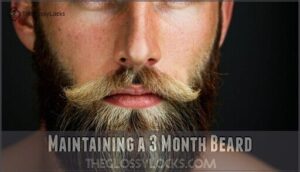This site is supported by our readers. We may earn a commission, at no cost to you, if you purchase through links.

Most importantly, resist the urge to trim for the first month. Your beard grows in patches before filling in, creating a roadmap only patience can complete.
The real difference-maker isn’t what you do to your beard—it’s understanding the science behind why some strategies work while others waste your time.
Table Of Contents
- Key Takeaways
- How Beard Growth Works
- Factors Affecting Beard Growth
- Preparing for Beard Growth
- The 3 Month Beard Growth Stage
- Common Challenges and Solutions
- Styling and Trimming Your Beard
- Achieving a Full Beard in 3 Months
- Frequently Asked Questions (FAQs)
- How long does a 3 month beard grow?
- How long does it take to grow a full beard?
- How long should a beard be after 3 months?
- When can you get a full beard?
- What should you consider during the first week of beard growth?
- How to grow a beard fast?
- Can I grow a beard in 3 months?
- What does a beard look like after 3 months?
- What is the fastest way to grow a full beard?
- Will my beard eventually fill in?
- Conclusion
Key Takeaways
- Your genetics determine your beard’s potential – Check your family’s facial hair patterns to set realistic expectations, as DNA controls follicle count and growth rate more than any product or technique.
- Focus on nutrition and health fundamentals – Eat adequate protein (1.2g per kg body weight), take biotin and vitamin D supplements, exercise regularly, and get quality sleep to optimize your body’s natural beard-growing conditions.
- Resist trimming for the first month – Your beard grows in patches before filling in, so avoid the urge to trim early and let slower-growing areas catch up to create fuller coverage.
- Apply beard oil daily and maintain proper hygiene – Use specialized beard products to prevent itchiness that causes most guys to quit around week six, and wash with beard-specific shampoo 2-3 times weekly to keep follicles healthy.
How Beard Growth Works
Before you can grow that impressive beard you’re dreaming of, you need to understand how hair actually grows on your face. Your beard follows a predictable three-phase cycle that determines when hairs appear, how long they get, and when they naturally shed.
Your beard’s destiny is written in your DNA—patience unlocks its full potential
The 3 Phases of Hair Growth
Your beard’s journey unfolds through three distinct growth phases that control your beard growth timeline. Understanding this Hair Follicle Cycle helps you master what’s happening beneath the surface.
- Anagen phase: Your active Growth Phase Duration lasts 2-4 months, determining how long hairs grow
- Catagen phase: A brief 2-3 week shift period between growth and rest
- Telogen phase: The Resting Phase Impact spans 3-4 months when follicles pause before restarting
These Anagen Phase Factors and Telogen Phase Transition create your unique Beard Growth Cycle, explaining why some areas fill faster than others.
Anagen, Catagen, and Telogen Phases Explained
Your anagen phase lasts 2-4 months, actively growing new beard hairs. The catagen phase follows for 2-3 weeks, shifting follicles from growth to rest. Finally, your telogen phase spans 3-4 months as hairs rest before shedding.
Understanding these growth phases helps you recognize why your beard growth timeline varies across different areas of your face. Recognizing the hair growth cycle is essential for promoting healthy beard growth.
Understanding The Growth Cycle
Picture your hair follicles as tiny factories working around the clock. Each follicle cycles through growth phases independently, creating unique growth patterns that determine your beard density.
The beard growth cycle operates on different cycle length schedules—some follicles rest while others grow vigorously. Understanding phase shift timing helps you recognize why your beard growth stages feel unpredictable.
Factors affecting beard growth influence your beard growth timeline, making patience your best friend.
Factors Affecting Beard Growth
Your beard’s growth potential isn’t just about willpower—it’s largely written in your DNA and shaped by factors you can’t control. Understanding what influences your facial hair helps you set realistic expectations and work with your natural growth pattern instead of against it.
Genetics and Family Traits
Your genetics determine if you’ll rock a full beard or face patchy struggles. Family histories reveal your beard blueprint—check your dad’s, granddad’s, and uncle’s facial hair for clues about your trait inheritance.
Consider these hereditary patterns:
- DNA factors set your follicle count at birth
- DHT sensitivity affects your beard growth rate
- Multiple genes influence your 3 month beard growth potential
Genetic testing can predict outcomes, but family beards tell the real story. Understanding your hormone levels is essential for grasping how genetics impact your beard growth.
Age and Hormonal Changes
Your hormone balance shifts dramatically throughout life, directly impacting your beard growth rate. During puberty, testosterone levels surge, kickstarting facial hair development. But here’s the catch—as you age, these same testosterone levels naturally decline, slowing your beard’s progress.
**Age factors matter more than you’d think.
** Healthy habits can help regulate hormones, but genetics still calls the shots on your final beard destiny.
Ethnicity and Cultural Variations
Depending on your heritage, you’ll notice distinct Ethnic Growth Patterns and Cultural Beard Styles. Mediterranean and Middle Eastern men often develop dense facial hair faster, while East Asian men usually experience lighter, patchy beard growth. These Genetic Variations create unique Racial Differences in beard density and growth rate.
Your Heritage Influences everything from texture to the 3Month Rule timeline, so embrace your genetics rather than fighting them.
Medical Conditions and Beard Growth
Medical conditions can throw a wrench in your beard game, but understanding them helps you take action. Certain health issues directly impact facial hair growth through genetics, hormones, or skin health:
- Alopecia barbae attacks hair follicles, causing patchy beard loss requiring alopecia treatment
- Hormone therapy may be needed for low testosterone affecting growth
- Skin conditions like fungal infections need medical supplements and proper hydration
Healthy habits, vitamins, and minerals support beard restoration when medical issues are addressed. Maintaining good beard health requires awareness of common beard problems to prevent complications.
Preparing for Beard Growth
Before you can grow that impressive three-month beard, you’ll need to set the foundation for success through proper nutrition, smart grooming habits, and realistic expectations.
Think of this preparation phase as training for a marathon—you wouldn’t just lace up your shoes and start running without getting your body ready first.
Nutrition and Overall Health
Beyond genetics, your body needs the right fuel to grow a thick beard. Protein intake above 1.2g per kilogram of body weight feeds your follicles, while vitamin supplements like biotin and vitamin D fill nutritional gaps. Don’t skip healthy fats from nuts and fish—they boost testosterone naturally. Hydration matters too; drink at least 2 liters daily for ideal follicle function.
| Nutrient | Daily Amount | Best Sources |
|---|---|---|
| Protein | 1.2g/kg body weight | Lean meats, eggs, legumes |
| Biotin | 30-100mcg | Nuts, seeds, sweet potatoes |
| Vitamin D | 1000-4000 IU | Fatty fish, fortified foods |
| Zinc | 11mg | Oysters, beef, pumpkin seeds |
| Omega-3s | 1-2g | Salmon, walnuts, flaxseed |
Healthy habits like regular exercise boost circulation and growth hormones. Quality sleep repairs follicles overnight. Balance matters—crash diets tank testosterone levels. Think of nutrient balance as your beard’s foundation. Vitamins and minerals work together, so eat varied whole foods rather than relying solely on supplements.
Grooming Habits for Healthy Beard Growth
Start smart with proper Grooming Habits that’ll transform your beard game. Use gentle Beard Care products—ditch regular soap for specialized beard wash and follow with Beard Oiling to prevent itchiness. Daily Beard Brushing distributes natural oils while Skin Exfoliation twice weekly removes dead cells. Strategic Beard Trimming keeps growth neat without sacrificing length. Investing in quality beard care products is essential for maintaining a healthy beard.
Essential Beard Growth Tips for your routine:
- Healthy Shaving practices protect follicles from damage and irritation
- Consistent Beard Grooming Routine creates the foundation for Healthy Beard Growth
- Quality tools make all the difference—invest in yourself
Managing Expectations and Patience
Success with beard growth tips starts with managing your growth mindset over three months. Your beard growth rate won’t match Instagram influencers, but patience tips make the difference.
- Beard goals: Set realistic timeline expectations for healthy beard growth
- Emotional support: Connect with beard communities for encouragement
- Managing beard growth: Track progress weekly, not daily
Remember, Rome wasn’t built in a day—neither was your epic beard.
The 3 Month Beard Growth Stage
By month three, your beard has moved past the awkward patchy phase and starts showing its true potential. You’ll notice fuller coverage, better definition, and a more mature appearance that’s ready for proper styling and maintenance.
What to Expect at 3 Months
After preparing properly, you’ll reach the three month beard landmark with mixed results. Your beard growth rate averages 1.5 inches, revealing distinct growth patterns and beard texture changes.
Progress tracking shows over 65% experience improved thickness, though full coverage remains elusive for many.
Beard density varies substantially—expect patchy spots alongside fuller areas as your beard growth cycle continues evolving toward maturity.
Maintaining a 3 Month Beard
Once you’ve hit the three month mark, your beard maintenance game needs to step up. Daily Beard Oil application keeps your facial hair healthy and prevents that dreaded itch. Beard Hygiene matters—wash regularly but don’t overdo it.
Here’s your essential beard care routine:
- Apply Beard Oil daily to nourish both hair and skin
- Use a quality Beard Brush to distribute oils evenly
- Wash with specialized beard shampoo 2-3 times weekly
- Focus on Skin Care underneath to prevent irritation
Your three month beard represents serious commitment to the beard growth cycle. Proper Beard Health maintenance now sets the foundation for long-term success.
Trimming and Shaping for Style
After maintaining your three-month beard, you’ll want to craft its shape for maximum impact. Think of trimming and shaping as sculpting your facial masterpiece—you’re revealing the beard that’s been hiding beneath all that growth.
Your beard isn’t just growing—it’s becoming the masterpiece you never knew you had
Your beard’s potential shines through proper technique:
- Master beard symmetry using shaping tools like quality trimmers and scissors for precision cuts
- Follow beard trimming tips that work with your natural growth patterns and face shape
- Apply styling products strategically to augment your chosen beard styles while maintaining facial harmony
Don’t rush this process. A beard shaping template can guide your first attempts, but remember—you’re not just beard grooming, you’re creating your signature look. Start conservatively with trimming and shaping. You can always remove more hair, but growing it back takes weeks. Focus on cleaning up your neckline and cheek borders first, then gradually perfect your style. To achieve a polished look, consider using high-quality beard trimmers for precise control over your beard’s length and shape.
Common Challenges and Solutions
Growing a beard for three months sounds simple, but you’ll face some real challenges along the way. **The good news is that every common problem has a practical solution that actually works.
Dealing With Patchiness and Uneven Growth
Patchiness happens to most guys—genetics decide your beard density, not your grooming skills. Beard Fillers can temporarily cover patchy areas while Growth Serums may boost follicle activity. Trim uneven texture shorter to create a uniform appearance. Let slower-growing spots catch up over 8-12 weeks. Patchy beards often improve with consistent beard maintenance and patience.
Managing Itchiness and Dryness
Conquering beard itch and dry skin doesn’t have to derail your three-month journey. Your face is practically screaming for moisture, so listen up.
- Apply beard oil daily – This moisturizing powerhouse fights dryness while soothing irritated skin beneath your whiskers.
- Choose gentle beard washes – Harsh soaps strip natural oils, making itchiness worse. Stick with sulfate-free formulas.
- Exfoliate weekly – Dead skin cells trap dirt and cause irritation. Gentle scrubbing promotes healthy beard growth and reduces flakiness.
These skin care basics transform your scratchy situation into smooth sailing toward beard mastery.
Keeping a Clean and Hygienic Beard
Clean facial skin properly before applying beard care products—dead skin cells can clog follicles and cause irritation. Wash your beard every 2-3 days with specialized beard shampoo, not regular soap that strips natural oils. Daily beard oil application keeps both skin and hair healthy. Use proper hygiene tips like cleaning your beard brush weekly and avoiding touching your face with dirty hands.
Comb out daily
Styling and Trimming Your Beard
Once your beard hits the three-month mark, you’ll need to start shaping and styling it to look intentional rather than wild. Strategic trimming and the right products transform your natural growth into a polished, professional appearance that refines your facial structure.
Defining The Neckline and Trimming Length
After growing your beard for three months, you’ll need proper neckline shaping and trimming techniques for a polished look. Your Adam’s apple acts as the perfect reference point for defining your beard’s lower boundary.
Here’s your trimming roadmap:
- Create a curved line two fingers above your Adam’s apple using quality edging tools
- Trim gradually – start longer and work shorter for better length control
- Check beard symmetry by comparing both sides in good lighting
Master these beard maintenance basics and you’ll transform that wild growth into a sharp, professional style that commands respect.
Combining and Detangling for Style
Anyone can master beard combing with the right approach. Start your beard grooming routine by selecting proper detangling tools—a beard comb for precision work or a boar bristle brush for volume. Work through tangles gently, starting from the tips and moving toward the roots. Use comb techniques that follow your natural growth pattern. This beard texturizing method prevents breakage while achieving your desired beard style.
Consistent trimming and shaping combined with proper styling products creates the foundation for effective beard maintenance. Understanding beard styling techniques is essential for a well-groomed appearance.
Using Beard Balm and Wax for Hold
Your beard’s styling arsenal needs both beard balm and beard wax for maximum control. Balm softens and conditions while providing light hold for everyday beard maintenance. Wax delivers stronger hold techniques for stubborn hairs and structured beard styling.
Start with a dime-sized amount of balm, then add wax for beard texturing. This combo transforms unruly beard growth into polished finesse.
Understanding beard care products is essential for achieving the desired beard style and maintaining overall beard health.
Achieving a Full Beard in 3 Months
You’re now at the three-month mark where your patience starts paying off with noticeable fullness and definition. While genetics ultimately determine your beard’s potential, combining proven lifestyle strategies with targeted interventions can help you enhance what you’ve got to work with, and reach the highest point.
Setting Realistic Expectations
Three key factors shape your beard goals: genetics, hormones, and time. Your growth mindset matters more than perfect coverage. Embrace patience building while managing realistic expectations about your three months timeline.
- Accept patchy spots – Factors affecting beard growth vary by person
- Track weekly progress – Your beard growth rate improves with expectation management
- Focus on density gains – Full beard development happens gradually
- Celebrate small wins – Every whisker counts toward your final result
Combining Lifestyle Strategies and Medical Interventions
Maximize your beard potential by stacking proven strategies. Lifestyle modifications like consuming biotin-rich foods and exercising boost natural testosterone. Medical supplements fill nutritional gaps, while topical minoxidil shows real results in clinical studies. Smart growth optimization combines both approaches for exceptional outcomes.
| Strategy Type | Benefits | Timeline |
|---|---|---|
| Lifestyle Changes | Natural testosterone boost | 4-6 weeks |
| Medical Interventions | Targeted follicle stimulation | 8-12 weeks |
| Combined Approach | Maximum density potential | 2-3 months |
Seeking Professional Advice for Concerns
Persistence matters when beard growth phase stalls despite your best beard care routine. If factors affecting beard growth seem overwhelming, seeking Professional Guidance through a Beard Consultation makes sense.
A Dermatologist Advice session can reveal hormonal issues affecting grooming for beard growth. They’ll assess whether Medical Help or beard growth supplements suit your situation. Sometimes Expert Opinion reveals solutions you hadn’t considered for achieving your three-month goal.
Understanding the beard growth process is vital for addressing specific challenges during the growth phase.
Frequently Asked Questions (FAQs)
How long does a 3 month beard grow?
Like a garden slowly awakening, your beard’s journey unfolds over three months. You’ll grow roughly 5 inches of facial hair, transforming from patchy stubble into fuller coverage as nature works its magic.
How long does it take to grow a full beard?
Growing a full beard usually takes 2-4 months, depending on your genetics and hormones. You’ll see patchy growth initially, but most men achieve decent coverage by the three-month mark with patience.
How long should a beard be after 3 months?
Your beard’s like a garden reaching maturity—after three months, expect 1-2 inches of length. Growth varies by genetics, but you’ll see fuller coverage and defined shape as patchy areas fill in naturally.
When can you get a full beard?
You can achieve a full beard usually within 2-6 months, depending on your genetics and age. Most guys see significant fullness by month three, though some need patience for patchy areas to fill in completely.
What should you consider during the first week of beard growth?
During the first week, you’ll face itchiness and patchy growth. **Resist the urge to shave or heavily trim.
**
Use beard oil daily, stay hydrated, and embrace the awkward phase—it’s temporary.
How to grow a beard fast?
Ironically, you can’t rush nature’s timeline. Focus on nutrition, sleep, and patience—beard growth maxes out at genetics-determined rates. Minoxidil might help, but there’s no true "fast" method.
Can I grow a beard in 3 months?
You can grow a decent beard in three months, but genetics determine your results. Most men see significant progress during this timeframe, though full density varies individually.
What does a beard look like after 3 months?
Like a sculptor’s masterpiece emerging from marble, your three-month beard reveals its true architecture. You’ll see fuller coverage, defined shape, and transformed patchy areas into a cohesive, mature beard ready for styling.
What is the fastest way to grow a full beard?
Unfortunately, there’s no magic shortcut to fast beard growth. Your genetics largely determine your timeline, but you can improve conditions by eating protein-rich foods, exercising regularly, getting quality sleep, and using beard oil to keep follicles healthy. **These steps can help optimize your beard’s growth potential.
Will my beard eventually fill in?
Your beard’s sparse spots won’t stay barren forever. With patience, many patchy areas gradually fill in during the three-month journey, transforming your facial landscape into fuller, more commanding territory.
Conclusion
Growing a beard is like building a house—you need solid foundations before focusing on the finishing touches. Your genetics set the blueprint, but proper nutrition, consistent care, and resisting premature trimming enhance your potential.
Remember that learning how to get a full beard in 3 months requires patience above all else. Don’t expect flawlessness in twelve weeks, but you’ll definitely see significant progress.
Stay consistent with beard oil, get quality sleep, and trust the process—your future bearded self will thank you.
- https://www.getjackblack.com/Beard-Wash.aspx
- https://nopoo.net/t/does-a-boar-bristle-brush-really-make-a-difference/656
- https://www.nytimes.com/wirecutter/reviews/best-beard-trimmer/
- https://thebeardclub.com/blogs/beard-culture/discover-beard-genetics
- https://roughneckbeardcompany.com/the-science-of-beard-growth/













